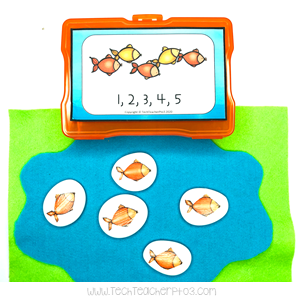Counting through nursery rhymes is one of the easiest ways to help students make meaningful connections to early maths concepts.
The Australian Curriculum (ACARA) Foundation Year students are required to learn:
...counting by naming numbers in sequences, initially to and from 20, moving from any starting point (ACMNA001)
and
connect number names, numerals and quantities, including zero, initially up to 10 and then beyond (ACMNA002)
Using Nursery Rhymes is the perfect marriage of rhythm and rhyme, counting skills, sequencing, retells and lots of fun!
Which nursery rhymes work best?
Here is my list of the counting nursery rhymes I feel work best with early years students for counting forwards, backwards and introducing early subtraction concepts to and from 10 or less:
1, 2, 3, 4, 5 Once I caught a fish alive
5 Little Speckled Frogs
5 Little Ducks
5 Currant Buns
5 Little Monkeys
10 In the Bed
Subscribers can download posters of each of these nursery rhymes for free from the Freebies Library. If you're not a subscriber, you can subscribe here and access many other free teaching resources.
Developing 1:1 Correspondence
Young students can tell you 'I can count!' and proceed to say 'one, two, three, four.. ' etc but place tangible objects in front of them and ask them to count them is often quite different. Students must first learn to touch each object (the 1:1) and count each object only once. To do this you will need concrete items such as stones, lolly sticks, counters or other objects. However, the beauty of teaching nursery rhymes alongside their maths concepts is that you can easily create concrete items that have a purpose, rather than random objects.
For example, here I have created story stones to go with the nursery rhyme 1, 2, 3, 4, 5 Once I caught a fish alive. This is the perfect introductory rhyme that many students already know. Can your student count each object only once when they move them?
Here is another nursery rhyme set of story stones I have created to teach 5 Little Ducks. This time it requires the student to count the ducks once each, then remove one and recount. This introduces students to the maths vocabulary of 'away' and other similar words that indicate subtraction has occurred in the story.
5 Little ducks went out one day, (count the ducks 1, 2, 3, 4, 5)
over the hills and far away (move all 5 ducks away from the pond)
mother duck said 'quack, quack, quack, quack'
but only 4 little ducks came back. (count 4 ducks and return them to the pond, consider and discuss the sum 5 - 1 = 4).
The story stones are so easy to create. I used flat white stones from the hardware store Bunnings where I also found Modpodge and brushes. Print the images and let them dry before cutting and sticking to rocks with the Modpodge. The felt and boxes were from Spotlight (craft store). Have each set stored ready for maths group activities.

Sequencing with nursery rhymes
You can get so much mileage out of nursery rhymes by using them as a sequencing activity as well. Place the number of objects in the correct order (try forwards first and then backwards, which is somewhat trickier for students).
Use printables to let students control the learning and get them to sequence the story themselves.
Using nursery rhymes for retells
Nursery rhymes work perfectly for introducing retells because of their simplicity. Below you can see how I've used the 5 Little Speckled Frogs nursery rhyme to see if students can sequence the story correctly. You can see the student has placed only one frog at the start of the story, but the story starts with 5 frogs, so you will need to check for understanding with this process.
You can find all of these printable resources in my Nursery Rhyme Counting Activity Bundle and if you're still undertaking distance learning, you may enjoy the Boom Learning version here.









Коментарі